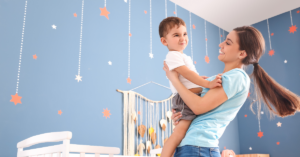Live In Au Pairs vs Live Out Au Pairs – What is the Difference?
Live In Au Pairs vs Live Out Au Pairs
Being an au pair is a unique cultural exchange experience that allows young people to live abroad, learn a new language, and gain valuable childcare experience. However, there are two main types of au pair arrangements: live-in and live-out. In this article, we explore the key differences between these two types of au pair arrangements, as well as some of the possible benefits and drawbacks of each.
Do Au Pairs Have to Live With You?
The advent of live-out au pairs is a relatively new trend emerging in recent years with the fundamental difference between the two types of au pairs being where they live. A live-in au pair lives with their host family in their home, while a live-out au pair lives in their own place.
Live-In Au Pair
A live-in au pair is an au pair who lives in the host family’s home for the duration of the au pair program.
A live-in au pair:
- has their own private bedroom, access to a bathroom, and share living spaces with the host family,
- is responsible for the care of the host family’s children and is usually expected to work between 25 and 35 hours per week,
- receives weekly pay, room, and board, and may also receive additional benefits such as subsidised language classes and use of a car,
- In some cases, if a host family is providing full board and lodging, a charge of €0.90 per hour worked (for board only), and €23.86 a week or €3.24 per day (for lodging only) can be deducted from an au pair’s weekly pay.
With a live-in au pair, you will have a more personal relationship because they are living in your house and spending more time with you and your family. This means that the relationship an au pair forms with their host family is often much closer than for a live-out au pair who may see the family less frequently as there are no ‘chance encounters’ around the house.
Live-Out Au Pair
On the other hand, a live-out au pair lives in their own accommodation.
A live-out au pair:
- lives in a separate rented room or apartment, while working for the host family,
- still has the same general responsibilities to provide care to the host family’s children,
- is expected to work the same number of hours as a live-in au pair, typically between 25 and 35 hours per week,
- receives weekly pay and may also receive additional benefits such as subsidised language classes or the use of the family car though more specifically for activities related to their au-pair duties such as drop-off and pick-up from school,
- if it is the au-pair’s preference to live-out then the au pair will likely be expected to pay for the rental accommodation from their weekly pay
Au pairs must adhere to the work hours of their host family, and can’t just make up their own schedule. If a host family has an unusual schedule (e.g., they work late) or if they need their au pair to be on call for emergencies at night or on weekends, it’s important that this is discussed and agreed with the au-pair in advance of agreeing the contract, given that this might be more difficult with a living-out arrangement.
Live-In versus Live-Out
From the au pair’s perspective, a live-in arrangement can offer a sense of belonging and integration within the host family. Living in the same home as the children allows for a closer relationship to develop and can make it easier for the au pair to understand and meet the needs of the children. Additionally, living in the home can save the au pair money on rent and other living expenses. However, living in close quarters with the host family can also be challenging, as it can make it difficult to maintain personal boundaries or privacy.
From the family’s perspective, it’s important to also assess their own ability and suitability to host an au pair. As with all things there are benefits to hosting, but there are other considerations too, for example, is there a suitable spare room available, which if not, may require the host family to opt for a live-out au pair arrangement.
The table below gives an overview of some of the potential benefits and drawbacks of each option.
| Live-In | Live-Out | |
| Family relationship | A sense of belonging for the au pair and a more personal connection. | Harder to form a bond with the children and may be less involved in family life. |
| Accommodation | A private room, and access to a suitable bathroom, must be available. | Rented accommodation separate to the host family’s home. |
| Board | Provided with 3 meals per day and expenses related to heating, additional electricity use etc are covered by the host family. | No requirement for the host family to provide 3 meals per day, and fewer additional costs related to bills. Unless otherwise agreed, the au pair is responsible for paying their own rent and bills which can be added stress and expense for an au pair. |
| Working hours | More flexibility and security as the family au pair is usually available to care for the children in case of an emergency. | Less flexibility, less security in times of emergency, and more of a requirement to be organised with the weekly schedule. |
| Learning opportunities | Enhanced opportunity for cultural exchange and learning. | Less opportunity to learn about each other’s culture, improve language skills or generally participate in the cultural experience. |
| Privacy | Less privacy as shared living spaces. | More privacy for both parties outside of au pair working hours. |
In summary, the decision between a live-in and live-out au pair arrangement is a highly personal one that should be based on the specific needs and preferences of both the au pair and the host family. Both options have their unique benefits and drawbacks, and the ideal choice will vary depending on the individual situation. It is essential for both parties to engage in open and honest communication and establish clear expectations prior to the start of any au pair arrangement.
We hope this blog is helpful in answering your queries, please feel free to share it with anyone you think might be interested to know more. You can sign up on Suresitter to get started in your journey as an au pair or host family.




![How much does a nanny cost in Ireland? [Updated 2023]](https://blog.suresitter.com/wp-content/uploads/2022/10/Nanny-and-children-playing-300x200.png)
